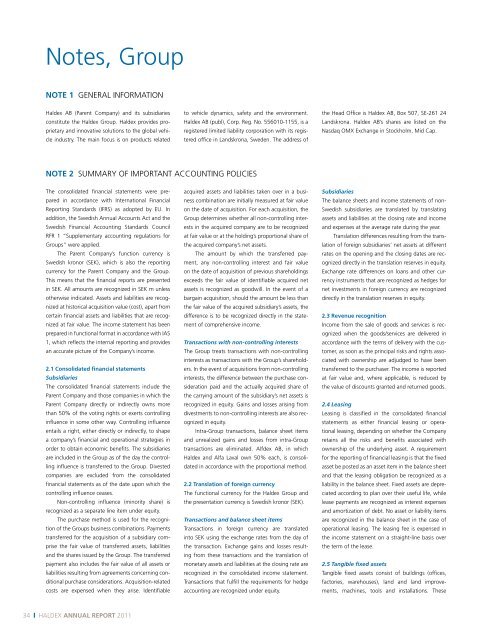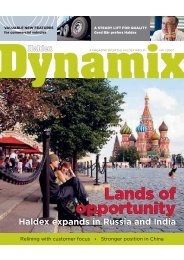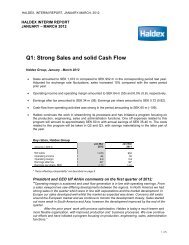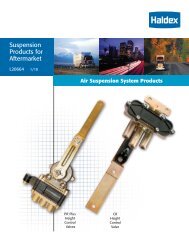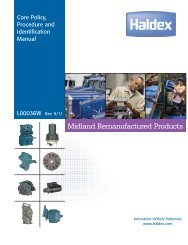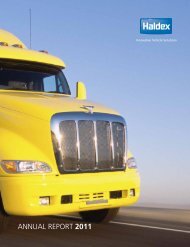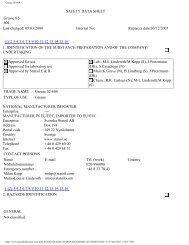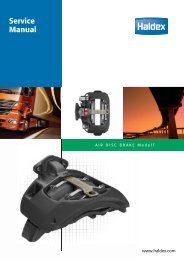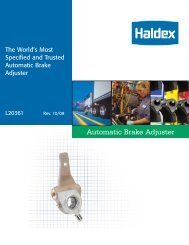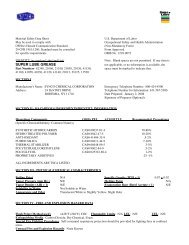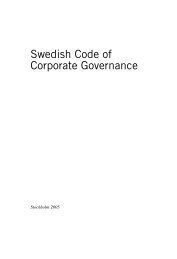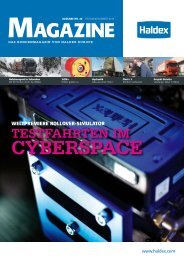Create successful ePaper yourself
Turn your PDF publications into a flip-book with our unique Google optimized e-Paper software.
notes, Group<br />
note 1 GeneRal InFoRMatIon<br />
<strong>Haldex</strong> aB (parent Company) and its subsidiaries<br />
constitute the <strong>Haldex</strong> Group. <strong>Haldex</strong> provides proprietary<br />
and innovative solutions to the global vehicle<br />
industry. the main focus is on products related<br />
note 2 SuMMaRY oF IMpoRtant aCCountInG polICIeS<br />
the consolidated financial statements were prepared<br />
in accordance with International Financial<br />
Reporting Standards (IFRS) as adopted by eu. In<br />
addition, the Swedish <strong>annual</strong> accounts act and the<br />
Swedish Financial accounting Standards Council<br />
RFR 1 “Supplementary accounting regulations for<br />
Groups” were applied.<br />
the parent Company’s function currency is<br />
Swedish kronor (SeK), which is also the reporting<br />
currency for the parent Company and the Group.<br />
this means that the financial reports are presented<br />
in SeK. all amounts are recognized in SeK m unless<br />
otherwise indicated. assets and liabilities are recognized<br />
at historical acquisition value (cost), apart from<br />
certain financial assets and liabilities that are recognized<br />
at fair value. the income statement has been<br />
prepared in functional format in accordance with IaS<br />
1, which reflects the internal reporting and provides<br />
an accurate picture of the Company’s income.<br />
2.1 Consolidated financial statements<br />
Subsidiaries<br />
the consolidated financial statements include the<br />
parent Company and those companies in which the<br />
parent Company directly or indirectly owns more<br />
than 50% of the voting rights or exerts controlling<br />
influence in some other way. Controlling influence<br />
entails a right, either directly or indirectly, to shape<br />
a company’s financial and operational strategies in<br />
order to obtain economic benefits. the subsidiaries<br />
are included in the Group as of the day the controlling<br />
influence is transferred to the Group. divested<br />
companies are excluded from the consolidated<br />
financial statements as of the date upon which the<br />
controlling influence ceases.<br />
non-controlling influence (minority share) is<br />
recognized as a separate line item under equity.<br />
the purchase method is used for the recognition<br />
of the Groups business combinations. payments<br />
transferred for the acquisition of a subsidiary comprise<br />
the fair value of transferred assets, liabilities<br />
and the shares issued by the Group. the transferred<br />
payment also includes the fair value of all assets or<br />
liabilities resulting from agreements concerning conditional<br />
purchase considerations. acquisition-related<br />
costs are expensed when they arise. Identifiable<br />
34 | <strong>Haldex</strong> <strong>annual</strong> report <strong>2011</strong><br />
to vehicle dynamics, safety and the environment.<br />
<strong>Haldex</strong> aB (publ), Corp. Reg. no. 556010-1155, is a<br />
registered limited liability corporation with its registered<br />
office in landskrona, Sweden. the address of<br />
acquired assets and liabilities taken over in a business<br />
combination are initially measured at fair value<br />
on the date of acquisition. For each acquisition, the<br />
Group determines whether all non-controlling interests<br />
in the acquired company are to be recognized<br />
at fair value or at the holding’s proportional share of<br />
the acquired company’s net assets.<br />
the amount by which the transferred payment,<br />
any non-controlling interest and fair value<br />
on the date of acquisition of previous shareholdings<br />
exceeds the fair value of identifiable acquired net<br />
assets is recognized as goodwill. In the event of a<br />
bargain acquisition, should the amount be less than<br />
the fair value of the acquired subsidiary’s assets, the<br />
difference is to be recognized directly in the statement<br />
of comprehensive income.<br />
Transactions with non-controlling interests<br />
the Group treats transactions with non-controlling<br />
interests as transactions with the Group’s shareholders.<br />
In the event of acquisitions from non-controlling<br />
interests, the difference between the purchase consideration<br />
paid and the actually acquired share of<br />
the carrying amount of the subsidiary’s net assets is<br />
recognized in equity. Gains and losses arising from<br />
divestments to non-controlling interests are also recognized<br />
in equity.<br />
Intra-Group transactions, balance sheet items<br />
and unrealized gains and losses from intra-Group<br />
transactions are eliminated. alfdex aB, in which<br />
<strong>Haldex</strong> and alfa laval own 50% each, is consolidated<br />
in accordance with the proportional method.<br />
2.2 translation of foreign currency<br />
the functional currency for the <strong>Haldex</strong> Group and<br />
the presentation currency is Swedish kronor (SeK).<br />
Transactions and balance sheet items<br />
transactions in foreign currency are translated<br />
into SeK using the exchange rates from the day of<br />
the transaction. exchange gains and losses resulting<br />
from these transactions and the translation of<br />
monetary assets and liabilities at the closing rate are<br />
recognized in the consolidated income statement.<br />
transactions that fulfill the requirements for hedge<br />
accounting are recognized under equity.<br />
the Head office is <strong>Haldex</strong> aB, Box 507, Se-261 24<br />
landskrona. <strong>Haldex</strong> aB’s shares are listed on the<br />
nasdaq oMx exchange in Stockholm, Mid Cap.<br />
Subsidiaries<br />
the balance sheets and income statements of non-<br />
Swedish subsidiaries are translated by translating<br />
assets and liabilities at the closing rate and income<br />
and expenses at the average rate during the year.<br />
translation differences resulting from the translation<br />
of foreign subsidiaries’ net assets at different<br />
rates on the opening and the closing dates are recognized<br />
directly in the translation reserves in equity.<br />
ex change rate differences on loans and other currency<br />
instruments that are recognized as hedges for<br />
net investments in foreign currency are recognized<br />
directly in the translation reserves in equity.<br />
2.3 revenue recognition<br />
Income from the sale of goods and services is recognized<br />
when the goods/services are delivered in<br />
accordance with the terms of delivery with the customer,<br />
as soon as the principal risks and rights associated<br />
with ownership are adjudged to have been<br />
transferred to the purchaser. the income is reported<br />
at fair value and, where applicable, is reduced by<br />
the value of discounts granted and returned goods.<br />
2.4 Leasing<br />
leasing is classified in the consolidated financial<br />
statements as either financial leasing or operational<br />
leasing, depending on whether the Company<br />
retains all the risks and benefits associated with<br />
ownership of the underlying asset. a requirement<br />
for the reporting of financial leasing is that the fixed<br />
asset be posted as an asset item in the balance sheet<br />
and that the leasing obligation be recognized as a<br />
liability in the balance sheet. Fixed assets are depreciated<br />
according to plan over their useful life, while<br />
lease payments are recognized as interest expenses<br />
and amortization of debt. no asset or liability items<br />
are recognized in the balance sheet in the case of<br />
operational leasing. the leasing fee is expensed in<br />
the income statement on a straight-line basis over<br />
the term of the lease.<br />
2.5 Tangible fixed assets<br />
tangible fixed assets consist of buildings (offices,<br />
factories, warehouses), land and land improvements,<br />
machines, tools and installations. these


